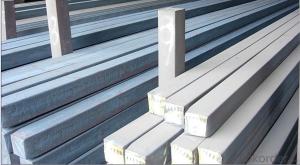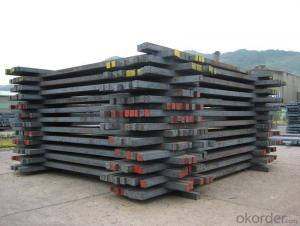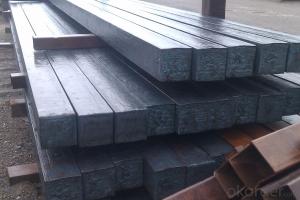Q235/3SP 115MM Blast Furnace Hot Rolled Steel Billet
- Loading Port:
- Tianjin
- Payment Terms:
- TT OR LC
- Min Order Qty:
- 2000 m.t.
- Supply Capability:
- 30000 m.t./month
OKorder Service Pledge
OKorder Financial Service
You Might Also Like
Description of Q235/3SP 115MM Blast Furnace Hot Rolled Steel Billet
Our hot dip galvanised steels consist of a steel substrate with a metallic zinc coating applied by means of a continuous hot dip galvanising process. Metallic zinc coatings are available in steel grades ranging from steel for bending and deep drawing applications, to structural steels and high yield strength steels.
A glossy surface finish obtained under specific skin-pass conditions (either non-skin-passed or skin- passed with smooth cylinders to obtain low roughness) can be provided if required at time of enquiry.
Advantage of Q235/3SP 115MM Blast Furnace Hot Rolled Steel Billet
Uncoated CR steel sheet With the features of in line with the international highest standards in demension and shape, excellent surface finish and properties, the products are mainly used in home appliance and automobile industries.
Galvanized steel sheet(include HDG and EG)
With the features of good corrosion resistance, the products are mainly used in automobile, home appliance, electronics, building and machinery manufacture industries, etc.
Precoated steel sheet With the features of enviromental protection and good processablility, long lasting surface durability, rich in colors, the products are maily used in building, home appliance and furniture industries, etc.
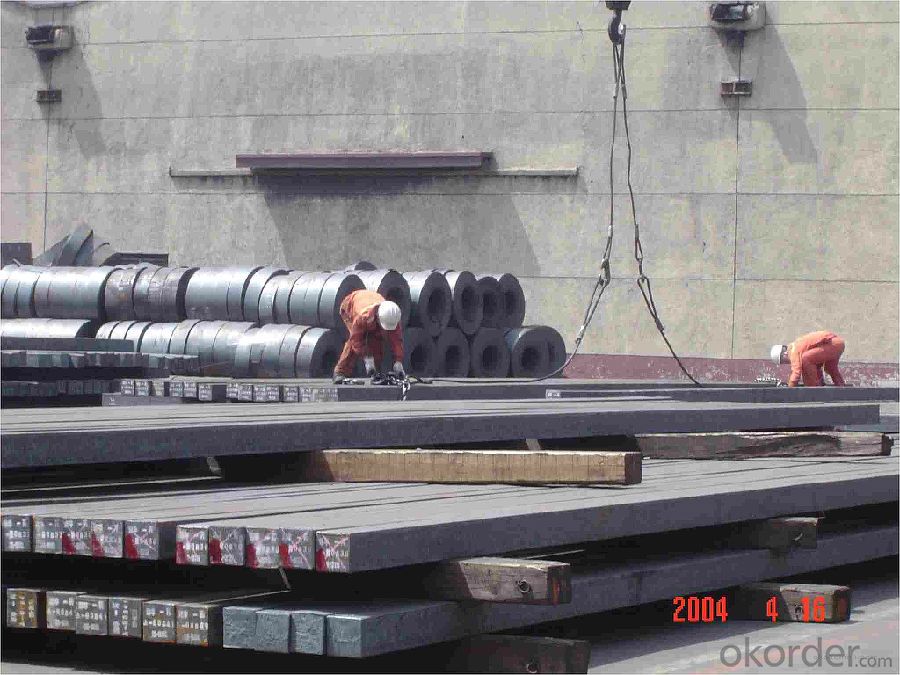
Applications of Q235/3SP 115MM Blast Furnace Hot Rolled Steel Billet
Our hot dip galvanised steels can be used in a very wide range of applications for industrial markets, both indoors and outdoors. Some of the most common applications are:
Building: wide sections for roofing and cladding, doors, door frames, metallic ceilings, partitions, structural members etc
Domestic appliances: all appliances for this sector (both white and brown goods) are manufactured with hot dip galvanised steels
Miscellaneous: electrical cabinets, aeraulic components, air conditioners, road signs etc
Zinc hot dip galvanised steel is suitable for contact with foodstuffs under certain conditions, as specified in European directive 89/109/EEC and French standard NF A 36-712-1. Please contact us for further information on this subject.
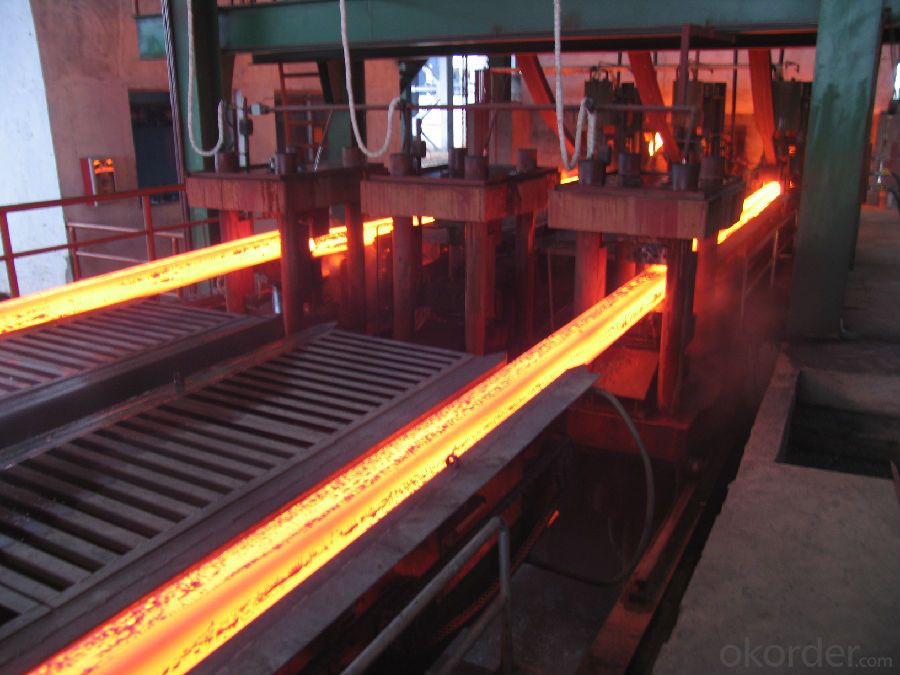
Specifications of Q235/3SP 115MM Blast Furnace Hot Rolled Steel Billet
Quality | Q/BQB 440-2003 | JIS G3312-1994 JIS G3321 | EN 10326-2004 | ASTM A653-02a |
EN 10327-2004 | (BASE PLATE) | |||
(BASE PLATE) | ||||
Commercial Steel | DC51D | SGCC SGLCC | DX51D+Z DX51D+AZ | CS Type A/B/C |
Forming Steel | St01,St02,St03 | SGCD1 SGLCD1 | FS Type A, Type B | |
Drawing | DC52D /DC53D | - | DX52D+Z DX52D+AZ | DDS TYPE A/C |
Steel | DX53D+Z DX53D+AZ | |||
Structural | S280GD (StE28) | SGC400 SGLC400 | S280D+Z DX54D+AZ | SS275 |
Steel | S350GD (StE34) | SGC440 SGLC440 | S350D+Z S350D+AZ | SS340 Class1 |
FAQ of Q235/3SP 115MM Blast Furnace Hot Rolled Steel Billet
We have organized several common questions for our clients,may help you sincerely:
1. How Can I Visit There?
Our company is located in Tianjin City, China, near Beijing. You can fly to Tianjin Airport Directly. All our clients, from home or aboard, are warmly welcome to visit us!
2. How Can I Get Some Sample?
We are honored to offer you sample.
3. Why choose CNBM?
Our delivery time about 15-20days for standard sizes, if you have other requirements like hardness, quanity and width ,it is about 20-40days. But don't worry we also try our best for the delivery time ,because time longer and our cost is higher.
- Q:What are the main factors affecting the impact toughness of steel billets?
- There are several main factors that can affect the impact toughness of steel billets. Firstly, the chemical composition of the steel plays a significant role. The presence of certain alloying elements such as carbon, manganese, and nickel can enhance the toughness of the steel. Higher carbon content generally results in increased hardness but can decrease impact toughness. On the other hand, the addition of manganese and nickel can improve toughness by promoting the formation of fine-grained structures. Secondly, the heat treatment process employed during the production of steel billets can greatly impact their toughness. Annealing and quenching processes can help to refine the microstructure of the steel, making it more resistant to cracking and brittle fracture. On the other hand, improper heat treatment or rapid cooling rates can lead to the formation of undesirable phases or microstructural defects, which can reduce the impact toughness. Thirdly, the presence of impurities and inclusions in the steel can also affect its toughness. Non-metallic inclusions, such as sulfides and oxides, can act as stress concentrators and initiate crack propagation during impact loading. Therefore, steel with lower levels of impurities and cleaner inclusion content tends to exhibit higher toughness. Furthermore, the grain size of the steel can have a significant influence on its toughness. Finer grain sizes generally result in improved toughness due to the increased number of grain boundaries that can act as barriers to crack propagation. Therefore, steel billets with smaller grain sizes are typically more resistant to brittle fracture. Lastly, the mechanical working processes, such as hot rolling or forging, can affect the toughness of steel billets. These processes can induce deformation and strain hardening, which can lead to an increase in strength but a potential decrease in toughness. Careful control of the deformation parameters is necessary to balance strength and toughness in steel billets. In summary, the impact toughness of steel billets is influenced by various factors including chemical composition, heat treatment, impurities and inclusions, grain size, and mechanical working processes. Understanding and optimizing these factors is crucial in producing steel billets with the desired level of toughness for specific applications.
- Q:What are the different surface treatments for improved surface hardness in steel billets?
- Some of the different surface treatments for improved surface hardness in steel billets include carburizing, nitriding, induction hardening, and boronizing. These treatments involve introducing carbon, nitrogen, or boron into the surface layer of the steel to enhance its hardness and wear resistance.
- Q:How do steel billets contribute to the manufacturing of aerospace components?
- The manufacturing of aerospace components heavily relies on steel billets, which are semi-finished products utilized as the initial material in creating various aerospace parts. The versatility of steel billets contributes significantly to the manufacturing of aerospace components. Steel possesses exceptional strength, durability, and corrosion resistance, making it an ideal material for aerospace applications. High-quality steel billets form a solid foundation for producing components that can withstand the extreme conditions encountered during aerospace operations. Steel billets find extensive use in manufacturing critical aerospace parts such as engine components, landing gear, structural frames, and fasteners. The billets undergo heating and are then subjected to various forming and machining processes. These processes, including forging, rolling, and extrusion, shape the steel billets into the desired components, ensuring they meet the aerospace industry's stringent requirements for strength, precision, and weight reduction. Additionally, steel billets offer remarkable design flexibility. They can be easily machined and shaped into intricate geometries, enabling manufacturers to create aerospace components with precise tolerances. This flexibility allows the production of lightweight yet sturdy parts, contributing to aircraft weight reduction and enhancing fuel efficiency. Moreover, steel billets possess superior metallurgical properties. By employing appropriate heat treatment and alloying techniques, the mechanical properties of the steel can be customized to meet specific aerospace requirements. This enables manufacturers to achieve the desired balance between strength, stiffness, and toughness in the final components, ensuring their ability to withstand the high-stress environments encountered in aerospace applications. In conclusion, steel billets play an indispensable role in the manufacturing process for aerospace components. Their versatility, strength, design flexibility, and metallurgical properties make them an excellent starting material for producing critical parts in the aerospace industry. Utilizing steel billets allows manufacturers to ensure the production of high-quality, reliable, and long-lasting components that meet the rigorous demands of the aerospace sector.
- Q:What industries use steel billets?
- Steel billets are widely used in various industries due to their strength, durability, and versatility. Some of the main industries that heavily rely on steel billets include construction, automotive, manufacturing, and energy. In the construction industry, steel billets are used for the production of structural components such as beams, columns, and girders. These components provide the necessary strength and support in buildings, bridges, and other infrastructure projects. The automotive industry utilizes steel billets for the manufacturing of various car parts, including engine components, chassis, and suspension systems. Steel billets are preferred in this industry due to their high strength-to-weight ratio, which improves fuel efficiency and overall performance. Manufacturing industries, such as machinery, equipment, and tool production, also heavily rely on steel billets. They are used to manufacture gears, shafts, valves, and other critical components that require high strength, durability, and precision. Furthermore, steel billets are essential in the energy sector, particularly in the production of oil and gas pipelines. These pipelines require steel billets of specific grades to withstand harsh conditions, high pressures, and corrosive environments. In addition to these main industries, steel billets find applications in other sectors such as shipbuilding, aerospace, mining, and agriculture. They are widely used wherever strength, durability, and reliability are crucial. Overall, steel billets have a diverse range of applications across various industries, thanks to their exceptional mechanical properties. The demand for steel billets remains strong, as they are an essential raw material in the production of critical components in numerous sectors.
- Q:What are the main challenges in the transportation of steel billets?
- The main challenges in the transportation of steel billets include ensuring proper handling and securing of the heavy and bulky loads, preventing damage or deformation during loading and unloading processes, and complying with safety regulations for transporting hazardous materials. Additionally, factors such as limited availability of specialized equipment, fluctuations in fuel prices, and coordinating logistics for long-distance shipments can pose challenges for efficient and cost-effective transportation of steel billets.
- Q:What are the different types of steel billet rolling defects?
- During the rolling process, various defects can arise in steel billets, which can have adverse effects on the final product's quality and integrity. The most commonly encountered types of steel billet rolling defects are as follows: 1. Surface cracks: These are minute cracks that manifest on the billet's surface. They can result from inadequate cooling or excessive rolling pressure. Surface cracks jeopardize the steel's strength and durability. 2. Center cracks: Inner core cracks occur when temperature control during the rolling process is incorrect. Center cracks can lead to structural weaknesses and reduced steel performance. 3. Scalloping: Scalloping refers to the formation of shallow depressions or grooves on the billet's surface. It usually arises due to uneven or improper rolling pressure distribution. Scalloping negatively impacts the steel's appearance and surface quality. 4. Lamination: Lamination defects involve the separation of layers within the billet. They can be caused by the presence of impurities or inclusions in the steel, as well as inadequate heating or rolling conditions. Lamination defects weaken the steel and increase the risk of failure. 5. Wavy edges: Wavy edges occur when the billet's edges become uneven or distorted during rolling. This can be the result of improper alignment or uneven pressure distribution. Wavy edges affect the steel's dimensional accuracy and overall quality. 6. Surface defects: Surface defects encompass scratches, pits, or other imperfections on the billet's surface. They may occur due to insufficient cleaning or handling procedures, as well as improper rolling conditions. Surface defects impact the steel's appearance and surface quality. In conclusion, these steel billet rolling defects hold significant implications for the final product's quality, performance, and safety. Manufacturers must closely monitor the rolling process and implement appropriate quality control measures to minimize the occurrence of these defects.
- Q:What is the role of steel billets in the manufacturing of offshore structures?
- Steel billets play a crucial role in the manufacturing of offshore structures as they serve as the foundational raw material for creating various components such as beams, columns, and plates. These billets are first heated and then shaped or molded into desired forms through processes like rolling or forging. Their high strength, durability, and resistance to corrosion make them ideal for withstanding the harsh marine environment in which offshore structures operate. Overall, steel billets are essential in ensuring the structural integrity and longevity of offshore structures, providing the necessary strength and stability to withstand the challenging conditions of the open seas.
- Q:How do steel billets contribute to the manufacturing of renewable energy systems?
- The manufacturing of renewable energy systems heavily relies on steel billets, as they serve as the necessary foundation for various components. These billets are essentially semi-finished steel products that are cast into specific shapes, making them highly adaptable and versatile for different renewable energy applications. Wind turbines, for instance, require a sturdy and stable structure to support the blades and generator. Steel billets are used to construct the tower, which acts as the backbone of the wind turbine. These towers must endure harsh weather conditions and bear the weight of the blades, making the strength and durability of steel crucial. Similarly, solar energy systems, particularly photovoltaic (PV) panels, also rely on steel billets. Steel frames are utilized to provide structural support for the PV panels, ensuring they are securely mounted and capable of withstanding various environmental conditions. Additionally, steel billets are used in the production of solar trackers, which optimize the positioning of PV panels to maximize energy generation by tracking the sun's path throughout the day. Moreover, steel billets contribute to the manufacturing of hydroelectric power systems. In hydroelectric power plants, large turbines are utilized to convert the energy from flowing water into electricity. These turbines necessitate strong and reliable components, such as shafts and mechanical parts, which are often made from steel billets. The high strength and corrosion resistance of steel make it an ideal material for these applications. Furthermore, steel billets are employed in the production of energy storage systems, like batteries. These billets are used to create durable and secure enclosures for the batteries, ensuring their protection and safe operation. Steel's ability to withstand high temperatures and resist fire makes it a suitable choice for battery housing and containment. In conclusion, steel billets are indispensable in the manufacturing of renewable energy systems, providing the required strength, durability, and versatility for various components. Whether it is wind turbines, solar panels, hydroelectric turbines, or energy storage systems, steel billets play a critical role in enabling the reliable and efficient generation of renewable energy.
- Q:What is the role of steel billets in the manufacturing of storage tanks?
- Steel billets play a crucial role in the manufacturing of storage tanks. These billets serve as the primary raw material for the construction of the tank's structural framework. They are essentially semi-finished steel products that are cast into a specific shape and size, typically in a rectangular or square form. The primary reason for using steel billets in the manufacturing of storage tanks is their exceptional strength and durability. Steel is renowned for its high tensile strength, which allows the tank to withstand the immense pressure and weight of the stored contents. Additionally, steel is resistant to corrosion, making it an ideal material for storage tanks that may hold various liquids or gases. Steel billets are also preferred for their malleability and versatility. They can be easily molded and welded into the desired shape, allowing for the customization of storage tanks to meet specific requirements. The flexibility of steel billets enables the construction of tanks of various sizes and capacities, accommodating different storage needs in industries such as oil and gas, chemical processing, water treatment, and many others. Furthermore, steel billets offer cost-effectiveness in the manufacturing process. The abundance of steel as a raw material and its recyclability contribute to lower production costs, making steel tanks a more economical choice compared to tanks made from other materials. Moreover, the longevity of steel tanks reduces maintenance and replacement costs over time, ensuring a higher return on investment for industries relying on storage tanks. In conclusion, steel billets play a vital role in the manufacturing of storage tanks due to their strength, durability, corrosion resistance, malleability, and cost-effectiveness. These billets form the core framework of the tanks, providing the necessary structural integrity to safely contain and store various liquids or gases. By utilizing steel billets, industries can rely on robust and reliable storage solutions that meet their specific storage requirements.
- Q:What are the different types of steel billet casting defects?
- During the casting process of steel billets, various types of defects may occur, impacting the final product's quality and performance. These defects can range in severity and have different effects on the billets. Common defects include: 1. Insufficient feeding of liquid metal during solidification can cause shrinkage defects, resulting in voids or cavities within the billet. This weakens the billet's strength and may lead to failure under stress. 2. Porosity defects are characterized by the presence of small gas bubbles or voids within the billet. They reduce density, weaken the material, and affect mechanical properties such as tensile strength and ductility. 3. Foreign substances, such as non-metallic particles, oxides, or impurities, can become trapped within the billet, resulting in inclusion defects. These negatively impact mechanical properties like ductility and increase brittleness. 4. Surface defects, like cracks, scabs, or uneven surfaces, can occur during casting, affecting the appearance and structural integrity of the billet. 5. Uneven distribution of alloying elements within the billet leads to segregation defects. This inconsistency in composition affects mechanical properties and overall performance. 6. During solidification, thermal stresses can cause cracks known as hot tears, weakening the billet and reducing its strength under stress. 7. When the liquid metal fails to completely fill the mold cavity, misruns occur, resulting in incomplete billets. This defect leads to reduced dimensions, poor surface finish, and compromised mechanical properties. Addressing and identifying these defects is crucial to ensure the production of high-quality and reliable steel products. Techniques such as proper mold design, controlling casting parameters, and process optimization can be employed to minimize these defects and improve the overall quality of the billet.
1. Manufacturer Overview |
|
|---|---|
| Location | |
| Year Established | |
| Annual Output Value | |
| Main Markets | |
| Company Certifications | |
2. Manufacturer Certificates |
|
|---|---|
| a) Certification Name | |
| Range | |
| Reference | |
| Validity Period | |
3. Manufacturer Capability |
|
|---|---|
| a)Trade Capacity | |
| Nearest Port | |
| Export Percentage | |
| No.of Employees in Trade Department | |
| Language Spoken: | |
| b)Factory Information | |
| Factory Size: | |
| No. of Production Lines | |
| Contract Manufacturing | |
| Product Price Range | |
Send your message to us
Q235/3SP 115MM Blast Furnace Hot Rolled Steel Billet
- Loading Port:
- Tianjin
- Payment Terms:
- TT OR LC
- Min Order Qty:
- 2000 m.t.
- Supply Capability:
- 30000 m.t./month
OKorder Service Pledge
OKorder Financial Service
Similar products
New products
Hot products
Related keywords

